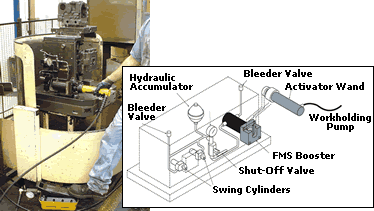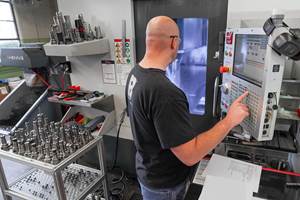Unplug-And-Play Hydraulic Workholding
An OEM and contract shop have found value in an unconventional, untethered hydraulic workholding method that uses mechanical energy transfer to charge a fixture's sealed hydraulic circuit. Free and easy HMC pallet movement is the result.
Share




Manufacturers that use hydraulic workholding to clamp parts for machining fit a standard profile. Their job runs typically are medium to high in quantity and their machining processes must offer the highest throughput and lowest scrap rate. That means speedy, repeatable part clamping is essential.
An OEM in Iowa differs from that profile, if only slightly, in that it uses a distinctive method to charge the hydraulic circuit on pallet-mounted fixtures used for its horizontal machining centers (HMCs). A nearby contract shop that supplies these fixtures to the OEM also uses the atypical system for some of its high-volume machining jobs.
Rather than using compressed air to charge a fixture's hydraulic circuit to secure parts for machining, this alternate technique is based on a mechanical transfer of energy. It uses a remote cylinder device that is temporarily attached to the fixture and pressurizes a completely sealed hydraulic circuit (think in terms of a car's braking system). Once parts are secured, the remote device is removed, while parts remain firmly clamped and pallet movement unrestrained.
Riding The Rail
The companies mentioned are located within a short drive of each other in central Iowa—Sauer-Danfoss in Ames and Mid-America Manufacturing (MAM) in the city of Nevada. Sauer-Danfoss produces hydraulic components for mobile equipment, so it's no surprise that the company uses fluid power to hold the pumps, motors and valves it produces at this facility during machining. MAM is both a contract machine shop and a custom fixture manufacturer. It supplies a number of fixtures to Sauer-Danfoss with the mechanical energy transfer system, and also uses that system on some of the seven HMCs in its facility.
Sauer-Danfoss has four separate Makino pallet systems that serve a number of HMCs. Because pallets are shuttled back and forth between loading station and machine, and because the pallets are rotated within the machine, it is impractical to have each fixture leashed with continuously attached hydraulic lines for part clamping. So the company began using a quick-disconnect hydraulic system to charge the circuit on each fixture, but found that dirt and debris were prone to enter into the hydraulic stream, leading to maintenance downtime and seal replacements.
Sauer-Danfoss has since standardized on the mechanical energy transfer method to power the hydraulic workholding circuit on the fixture. Tom Taylor, tool designer, says that his Ames facility has nearly 70 fixtures with the mechanical energy system that are used on 36 HMCs. Let's take a closer look at this hydraulic workholding technique and its main components.
Mechanical Push
The mechanical energy transfer system was developed by Enerpac (Milwaukee, Wisconsin). The system has three key components—hydraulic booster, activator wand and activator pump (see the schematic to the right). The wand is a high-pressure remote hydraulic cylinder that is plumbed to a footswitch-activated pump. After the fixture is cleaned of debris and the operator mounts a new part, a shut-off valve—located in the circuit just after the fixture-mounted booster—is opened. The operator then inserts the wand into the booster. When the 10,000-psi pump is activated, the wand's cylinder extends into the booster, pushing a piston which pressurizes the fixture's hydraulic circuit (circuit pressure is typically half that of the wand). When peak circuit pressure is reached, the operator will close the shut-off valve which prevents fluid from flowing back into the booster and keeps the parts firmly clamped even after the wand is depressurized and removed from the booster. The pallet is now ready to be shuttled to an HMC.
To remove parts from the fixture after machining, the operator will open the shut-off valve to allow fluid back into the booster. The hydraulic clamps will then move up and rotate out of the way (in the case of swing clamps), allowing the part to be removed.
Considering the number of pallets and machines in each pallet system, part positioning variance is bound to be an issue. To account for any differences, Sauer-Danfoss probes parts once the pallet is shuttled into the machine. The probe will touch off on a previously machined known location (like a bolt hole) in order to obtain the part's actual position inside the machine.
Hydraulic Consistency
MAM uses hydraulic workholding for its contract work if the volume is sufficient, according to Jason Elsberry, design manager. "We use hydraulic workholding primarily for consistency," says Mr. Elsberry. "You can supply clamping torque values and tell operators to use torque wrenches when clamping, but that doesn't always happen. Every operator will have a different sequence to clamp the part, which can also make a difference as to whether a part is secured properly."
For Sauer-Danfoss and other high-production manufacturers that use hydraulic workholding, fast clamping speed and reduced setup time are equally important, especially in lean manufacturing production schemes. The mechanical energy transfer method of hydraulic workholding offers Sauer-Danfoss a good base from which other setup-reducing techniques can sprout.
Getting A Visual
MAM has a lot of experience designing fixtures using the mechanical energy transfer system. As a good part design is driven by innovation and creativity, so too is a good fixture design. Part designers are constrained by physical limitations of the final assembly, while fixture designers are constrained by part geometry, machine tool envelope, the total number of parts to be held and the number of machining operations the parts will receive. Hydraulic workholding fixtures, especially those using the mechanical energy transfer system, add another layer of complexity because of the piping, valves and other necessary circuit components.
One of the ways that MAM speeds the design of its congested fixture projects is through a 3D CAD system from Solidworks (Concord, Massachusetts). One of the biggest advantages of 3D CAD in terms of fixture design is the capability to visualize the layout of the hydraulic circuit components. A 3D CAD fixture model can be sectioned in any desired plane to quickly check for fixture component interferences. (Many workholding component suppliers assist in speeding the design process by offering 3D CAD drawings on their Web sites that can be download and imported into the fixture drawing, eliminating some drawing time.)
MAM tries to conserve fixture space by using manifolds where possible. External rigid tubing is less expensive than manifolds, but it has drawbacks. One is the tendency to collect chips. The other is the possibility that the machine's cutting tool could nick the tubing, causing a leak. Manifolds offer a cleaner fixture design, and manifold-mounted components are typically easier to replace. Similar to the manual-versus-power workholding debate, the choice to use manifolds depends on the size of the production run and time allotted for fixture design and manufacture. "We will try to use a plate or portion of the tombstone weldment itself as a manifold," Mr. Elsberry explains.
Fixture weight is another design constraint, as the total weight of finished fixture loaded with hydraulics and parts to be machined must not exceed the capacity of the machine's pallet. The 3D system can not only automatically calculate total fixture weight, but also locate the fixture's center of gravity. This is helpful in determining where to locate hoist points in order to maintain fixture balance during installation onto a pallet.
Related Content
Medical Shop Performs Lights-Out Production in Five-Axes
Moving to five-axis machining enabled this shop to dramatically reduce setup time and increase lights-out capacity, but success relied on the right combination of workholding and automation.
Read MoreRail Manufacturer Moves Full Steam Ahead with Safe, Efficient Workholding Solution
All World Machinery Supply paired a hydraulic power unit with remote operating capabilities in a custom workholding system for Ahaus Tool & Engineering.
Read MoreCustom Workholding Shaves Days From Medical Part Setup Times
Custom workholding enabled Resolve Surgical Technologies to place all sizes of one trauma part onto a single machine — and cut days from the setup times.
Read MoreLean Approach to Automated Machine Tending Delivers Quicker Paths to Success
Almost any shop can automate at least some of its production, even in low-volume, high-mix applications. The key to getting started is finding the simplest solutions that fit your requirements. It helps to work with an automation partner that understands your needs.
Read MoreRead Next
Registration Now Open for the Precision Machining Technology Show (PMTS) 2025
The precision machining industry’s premier event returns to Cleveland, OH, April 1-3.
Read More5 Rules of Thumb for Buying CNC Machine Tools
Use these tips to carefully plan your machine tool purchases and to avoid regretting your decision later.
Read MoreBuilding Out a Foundation for Student Machinists
Autodesk and Haas have teamed up to produce an introductory course for students that covers the basics of CAD, CAM and CNC while providing them with a portfolio part.
Read More



































